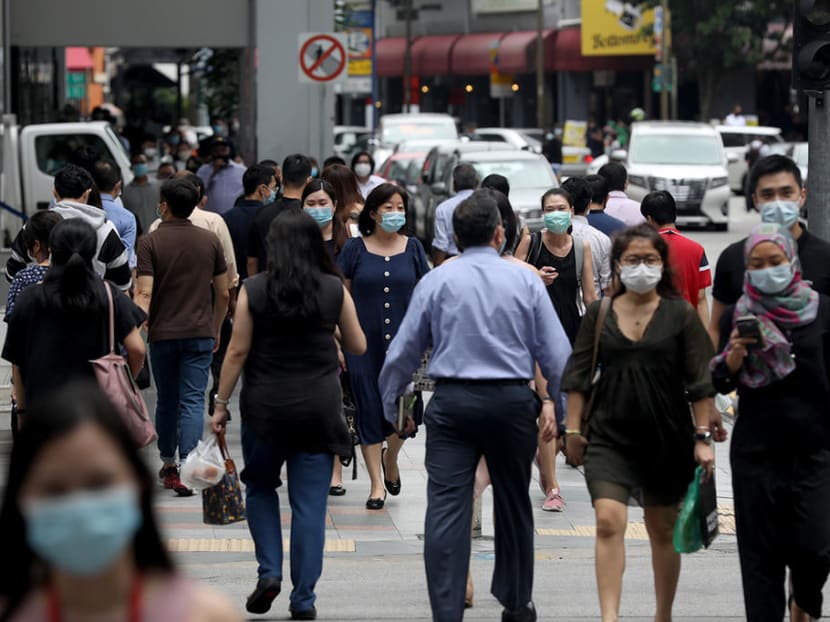Resident employment rate rises for 2nd straight year; real income grows despite high inflation
SINGAPORE — The resident employment rate rose for a second straight year as the labour market continued to see broad-based improvement in 2022, with real income growth increasing from a year ago.

- Resident employment rate was 67.5 per cent for 2022, up 0.3 percentage points from 2021
- Real income growth for 2022 was 2.1 per cent, up from 0.9 per cent in 2021
- Unemployment rate fell for both PMETs (3.4 to 2.6 per cent) and non-PMETs (5.1 per cent to 4.4 per cent)
SINGAPORE — The resident employment rate rose for a second straight year as the labour market continued to see broad-based improvement in 2022, with real income growth increasing from a year ago.
The employment rate for residents aged 15 and over rose to 67.5 per cent in June this year, up 0.3 percentage points from June 2021, the Ministry of Manpower (MOM) reported. An advance release of its annual Labour Force in Singapore report was put out on Thursday (Dec 1).
The employment rate last year had already surpassed the 65.2 per cent recorded in June 2019 before the Covid-19 pandemic.
“If ranked against Organisation for Economic Co-operation and Development (OECD) countries on overall employment rate, Singapore would place third,” MOM said.
WAGE GROWTH
Real median income growth — income growth after taking into account inflation — was 2.1 per cent this year, up from 0.9 per cent in 2021.
However, the growth this year was still lower than in the years before the pandemic when inflation was lower. Real median income growth was 3.8 per cent a year on average between 2014 and 2019.
The median income of full-time employment residents was S$5,070 as of June this year, up from S$4,680 last year.
For lower-income workers at the 20th percentile, real income grew 4.8 per cent, slightly faster than the 4.4 per cent growth last year. This came on the back of initiatives to lift lower-wage worker salaries, such as the Progressive Wage Model, MOM said.
As a result of the stronger growth, the wage gap between the 20th and 50th percentile has narrowed. The income ratio between the two rose from 0.53 in 2021 to 0.55 this year, the highest since 2004.
UNEMPLOYMENT
The unemployment rate fell across occupations. For professionals, managers, executives and technicians (PMETs), it fell from 3.4 per cent to 2.6 per cent. For non-PMETs, it fell from 5.1 per cent to 4.4 per cent.
The long-term unemployment rate also dropped to around pre-Covid levels for both PMETs (0.8 to 0.5 per cent) and non-PMETs (0.9 to 0.7 per cent).
The rate of time-related under-employment, referring to part-timers who are willing to engage in extra work, returned to the pre-Covid range as a result of business activities resuming to pre-Covid levels.
It fell from 3.5 per cent in 2021 to 3 per cent this year, with notable improvements for groups that were hit harder from the pandemic including older workers as well as those without tertiary qualifications.
Among employees, the share of non-permanent jobs also fell to pre-pandemic levels (11 per cent), with the scale-back of Covid-related temporary jobs alongside the relaxation of pandemic restrictions and the tight labour market.
BROAD-BASED IMPROVEMENT
The share of residents in PMET roles increased: They made up 64 per cent of all employed residents as of June 2022, up from 62 per cent a year ago — a continued increase for at least 10 consecutive years.
MOM said that the higher share reflected a highly educated workforce and sustained employment growth in sectors such as information and communications, finance and insurance as well as professional services.
The report also said that there were fewer people outside the workforce who were not actively seeking a job out of a belief that their search would not yield results, reflecting a strong recovery from the height of the pandemic in 2020.
The number of residents discouraged from seeking work fell from 11,600 in 2021 to 8,900 this year, making up 0.4 per cent this year, down from 0.5 per cent last year.
Although the improvements were across most age and education groups, older residents aged 60 and older saw a substantial improvement, while the proportion of discouraged workers among those with below-secondary-school qualifications was still slightly above its pre-Covid average.
“The broad-based improvement in resident labour force performance reflects the continued economic recovery and the gradual normalisation of business and social activities,” MOM said, as it urged employers and workers to tap government programmes to speed up workforce transformation.
“This will enable us to develop our workers and build a more competitive and resilient workforce, while ensuring that wage growth is sustainable and supported by productivity growth.”











